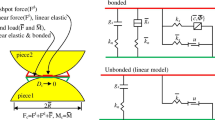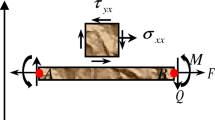Abstract
The mechanism of rock fracture evolution under loading has always been the focus of rock mechanics community. In this paper, to realize the development of rock crack propagation simulation system based on ABAQUS platform, the failure criterions which involve maximum tensile stress criterion, the maximum compressive stress criterion and the Mohr–Coulomb failure criterion (M–C) are programmed into the VUMAT subroutine, and the failure element deletion algorithm is introduced to investigate the deformation and failure process of rock blocks under load. Then, the proposed system is used to analyze the progressive failure process of rock samples under loading. By comparing with the test results, the causes and characteristics of crack expansion are studied, meanwhile the different forms of the rock failure process are explored.













Similar content being viewed by others
Data Availability
Enquiries about data availability should be directed to the authors.
References
Aliabadian Z, Sharafisafa M, Mortazavi A, Maarefvand P (2014) Wave and fracture propagation in continuum and faulted rock masses: distinct element modeling. Arab J Geosci 7:5021–5035
Chen JC, Zhou L, Chemenda AI, Xia BW, Su XP, Shen ZH (2020) Numerical modeling of fracture process using a new fracture constitutive model with applications to 2D and 3D engineering cases. Energy Sci Eng 8(7):2628–2647
Cheng L, Yang SQ, Liu XG (2012) Test and simulation study on crack growth characteristics of defective sandstone. J Min Saf Eng 29(05):719–724 ((in Chinese))
Feng Y, Gray K (2019) XFEM-based cohesive zone approach for modeling near-wellbore hydraulic fracture complexity. Acta Geotech 14:377–402
Gui YL, Zhao ZY, Zhou HY, Wu W (2016) Numerical simulation of P-wave propagation in rock mass with granular material-filled fractures using hybrid continuum-discrete element method. Rock Mech Rock Eng 49:4049–4060
Guo XC (2020) Numerical simulation of pore and fracture propagation under uniaxial stress. Coal Geol Explor 48(02):179–186+194 (in Chinese)
Huang JW, Jin TY, Chai Z, Barrufet M, Killough J (2019) Compositional simulation of fractured shale reservoir with distribution of nanopores using coupled multi-porosity and EDFM method. J Petrol Sci Eng 179:1078–1089
Li K, Wang Y, Huang X (2012) DDM regression analysis of the in-situ stress field in a non-linear fault zone. Int J Miner Metall Mater 19:567–573
Li K, Huang L, Huang X (2014) Propagation simulation and dilatancy analysis of rock joint using displacement discontinuity method. J Cent South Univ 21:1184–1189
Li TC, Lyu LX, Zhang SL, Sun JC (2015) Development and application of a statistical constitutive model of damaged rock affected by the load-bearing capacity of damaged elements. J Zhejiang Univ Sci A 16:644–655
Li TC (2005) CT test and theoretical analysis of three-dimensional fracture propagation. Graduate University of Chinese Academy of Sciences (Wuhan Institute of Rock and Soil Mechanics) Wuhan Hubei China (in Chinese)
Li X (2012) Gleeble Numerical simulation and experimental verification of Joule Effect in thermo-mechanical simulation. Shanghai Jiao Tong University Shanghai China (in Chinese)
Marji MF (2015) Simulation of crack coalescence mechanism underneath single and double disc cutters by higher order displacement discontinuity method. J Cent South Univ 22:1045–1054
Matsuda Y, Iwase Y (2002) Numerical simulation of rock fracture using three-dimensional extended discrete element method. Earth Planet Spce 54:367–378
Miao ST, Pan PZ, Wu ZH, Li SJ, Zhao SK (2018) Fracture analysis of sandstone with a single filled flaw under uniaxial compression. Eng Fract Mech 204:319–334
Ofoegbu GI, Smart KJ (2019) Modeling discrete fractures in continuum analysis and insights for fracture propagation and mechanical behavior of fractured rock. Rineng 4:100070
Qian XK, Liang ZZ, Liao ZY, Wang K (2020) Numerical investigation of dynamic fracture in rock specimens containing a pre-existing surface flaw with different dip angles. Eng Fract Mech 223:106675
Sanchez ECM, Cordero JAR, Roehl D (2020) Numerical simulation of three-dimensional fracture interaction. Comput Geotech 122:10352
Sheng M, Li GS, Sutula D, Tian SC, Stephane PAB (2018) XFEM modeling of multistage hydraulic fracturing in anisotropic shale formations. J Petrol Sci Eng 162:801–812
Silva VRSD, Ranjith PG (2020) A study of rock joint influence on rock fracturing using a static fracture stimulation method. J Mech Phys Solids 137:103817
Sun HF, Yang YM, Ju Y, Zhang QG, Peng RD (2014) Numerical analysis of coal and rock deformation failure and energy release under excavation unloading condition. J China Coal Soc 39(02):258–272 ((in Chinese))
Sun H, Liu XL, Zhang SG, Nawnit K (2020) Experimental investigation of acoustic emission and infrared radiation thermography of dynamic fracturing process of hard-rock pillar in extremely steep and thick coal seams. Eng Fract Mech 226:06845
Tang JH, Chen XD, Dai F (2020) Experimental study on the crack propagation and acoustic emission characteristics of notched rock beams under post-peak cyclic loading. Eng Fract Mech 226:106890
Tang Q, Li YA (2015) Particle flow simulation of the effect of confining pressure on rock crack propagation. J Changjiang Acad Sci 32(04):81–85 ((in Chinese))
Tripoppoom S, Yu W, Huang HY, Sepehrnoori K, Song WJ, Dachanuwattana S (2019) A practical and efficient iterative history matching workflow for shale gas well coupling multiple objective functions, multiple proxy-based MCMC and EDFM. J Petrol Sci Eng 176:594–611 ((in Chinese))
Trivino LF, Mohanty B (2015) Assessment of crack initiation and propagation in rock from explosion-induced stress waves and gas expansion by cross-hole seismometry and FEM-DEM method. Int J Rock Mech Min 77:287–299
Wang H, Jiang C, Zheng PQ, Zhao WJ, Li N (2020b) A combined supporting system based on filled-wall method for semi coal-rock roadways with large deformations. Tunn Undergr Sp Tech 99:103382. https://doi.org/10.1016/j.tust.2020.103382
Wang T, Liu ZL, Zeng QL, Gao Ym, Zhung Z (2017) XFEM modeling of hydraulic fracture in porous rocks with natural fractures. Sci China Phys Mech 60:084612
Wang C, Ran QQ, Wu YS (2019) Robust implementations of the 3D-EDFM algorithm for reservoir simulation with complicated hydraulic fractures. J Petrol Sci Eng 81:106229
Wang S, Li DG, Mitri H, Li HM (2020a) Numerical simulation of hydraulic fracture deflection influenced by slotted directional boreholes using XFEM with a modified rock fracture energy model. J Petrol Sci Eng 193:107375
Wang H, Jiang C, Zheng PQ, Li N, Zhan YB (2020c) Deformation and failure mechanism of surrounding rocks in crossed-roadway and its support strategy. Eng Fail Anal 116:104743. https://doi.org/10.1016/j.engfailanal.2020c.104743
Wang H (2009) Research on fracture propagation mechanism and Numerical Simulation on three-dimensional surface of rock. Shandong University of Science and Technology Qingdao Shandong China (in Chinese)
Wu ZJ, Zhang PL, Fan LF, Liu QS (2019) Numerical study of the effect of confining pressure on the rock breakage efficiency and fragment size distribution of a TBM cutter using a coupled FEM-DEM method. Tunn Undergr Sp Tech 88:260–275
Wu GS, Yu WJ, Zuo JP, Du SH (2020a) Experimental and theoretical investigation on mechanisms performance of the rock-coal-bolt (RCB) composite system. Int J Min Sci Technol 30(6):759–768
Wu Z, Zhou Y, Weng, L, Liu QS, Xiao Y (2020b) Investigation of thermal-induced damage in fractured rock mass by coupled FEM-DEM method. Comput Geosci
Xia ZG, Wang KY, Ge FY (2020) Special hole elements for simulating the heat conduction in two-dimensional cellular materials. Compos Struct 246:112383
Yang WM, Geng Y, Zhou ZQ, Li LP, Gao CL, Wang MX, Zhang DS (2020) DEM numerical simulation study on fracture propagation of synchronous fracturing in a double fracture rock mass. Geomech Geophys Geo-Energ Geo-Resour 6:39
Yu WJ, Wu GS, Pan B, Wu QH, Liao Z (2021) Experimental investigation of the mechanical properties of sandstone–coal–bolt specimens with different angles under conventional triaxial compression. Int J Geomech 21(6):04021067
Acknowledgements
This work is financially supported by the National Natural Science Foundation of China (No. 51804182), the Plan for Outstanding Youth Innovation Teams in College and University of Shandong Province, China (No. 2019KJG007), the Shandong Provincial Natural Science Foundation, China (No. ZR2020ME097). The Graduate Education Quality Improvement Plan of Shandong Province, China (No. SDYAL21062).
Funding
The authors have not disclosed any funding.
Author information
Authors and Affiliations
Corresponding author
Ethics declarations
Conflict of interest
The authors declare that they have no known competing financial interests or personal relationships that could have appeared to influence the work reported in this paper.
Additional information
Publisher's Note
Springer Nature remains neutral with regard to jurisdictional claims in published maps and institutional affiliations.
Rights and permissions
About this article
Cite this article
Wang, H., Zhou, H., Shang, S. et al. Development and Application of Rock Fracture Propagation Numerical Simulation System. Geotech Geol Eng 40, 3075–3090 (2022). https://doi.org/10.1007/s10706-022-02080-2
Received:
Accepted:
Published:
Issue Date:
DOI: https://doi.org/10.1007/s10706-022-02080-2




